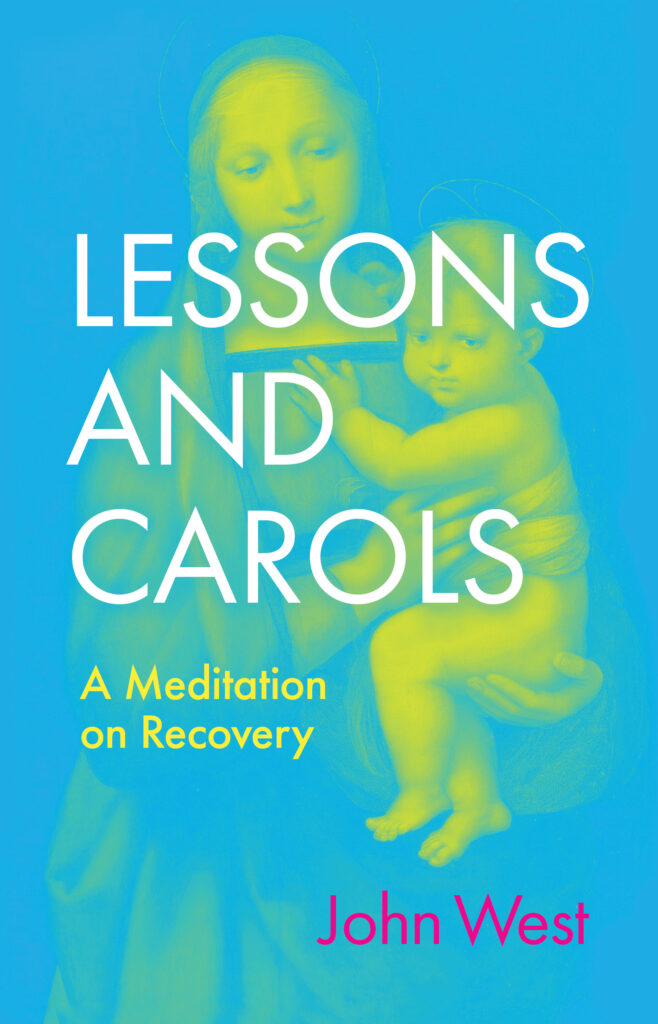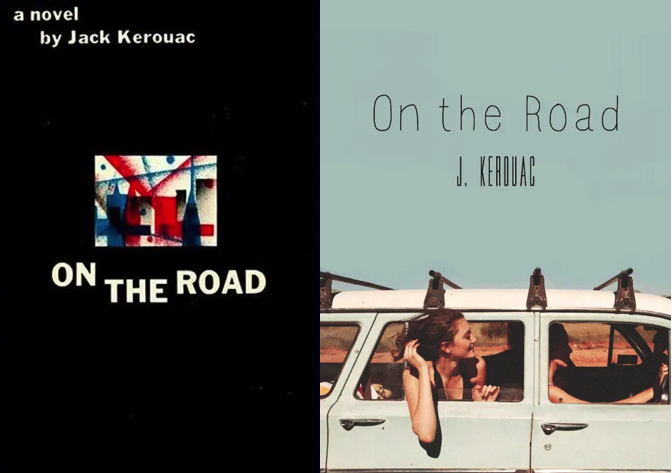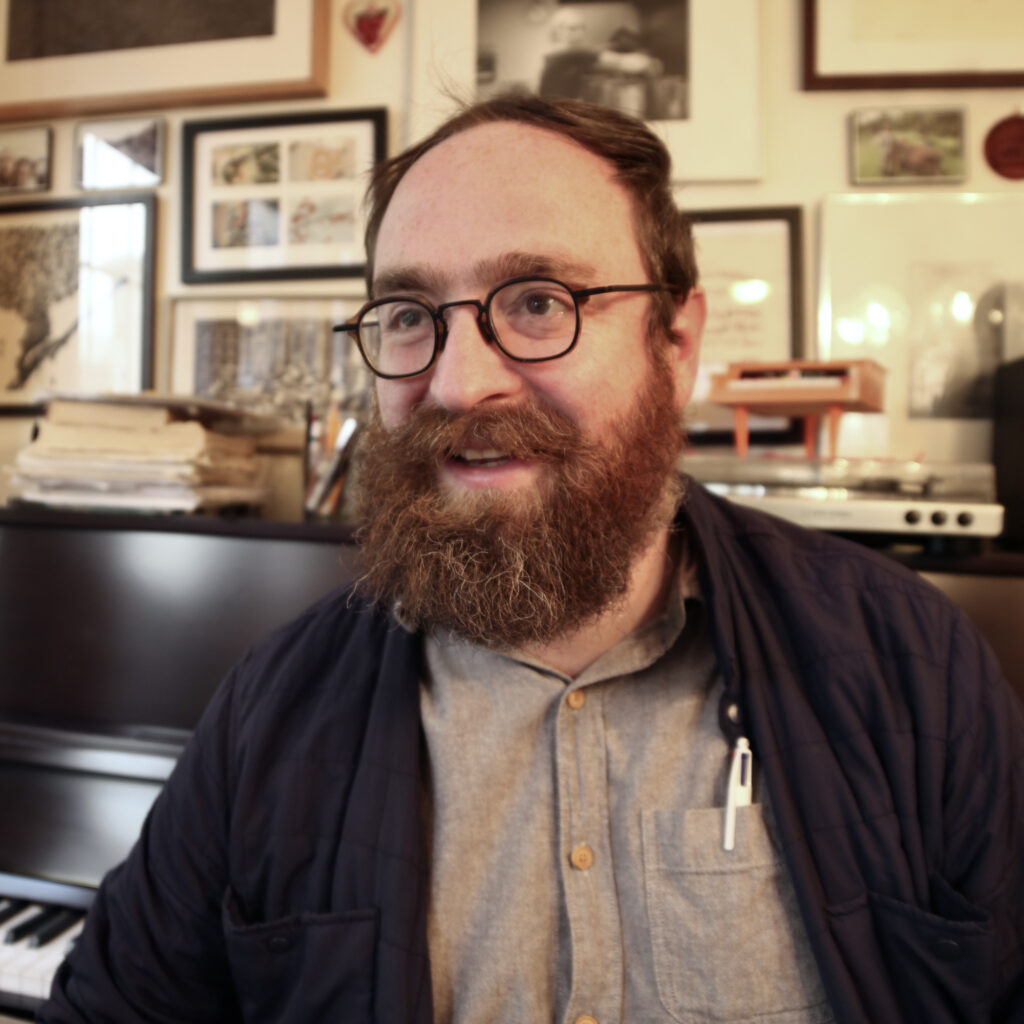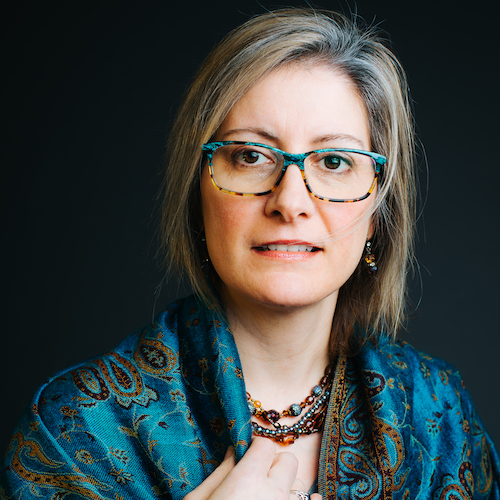Interview by Lara Lillibridge
Maybe redemption is not a place you find, but a system of mapmaking. Sketch a land. Pencil in dragons. Imagine it real, resplendent, and broken under a waxing moon.

Lessons and Carols: A Mediation on Recovery is a genre-bending memoir that explores the aftershocks of alcoholism and mental illness through a fresh look at the powers of poetry, ritual, and community. As a new parent, West grapples with his own fragmented recovery and grief for the friends he lost to addiction, asking if anyone can really change, or if we are always bound to repeat the past.
Echoing the form of a traditional Anglican Christmas service of stories and songs, West’s lyrical prose invites readers into an unorthodox rendition of the liturgy called Lessons and Carols. Each December, a faithful circle of irreligious friends assembles to eat and sing and re-imagine an old story about love made flesh. In that gathering’s glow, resentments turn to quiet wonder at the ways a better world can appear.
Both tender and bracing, West’s poetic meditation of the possibilities of change will resonate deeply with anyone who has tired of their own destructive loops. In this stirring account of recovery, redemption remains elusive—and also a promise as tangible as a newborn.
Hardscrabble winter, gray and lonely, requires Christmas. Or, rather, in its depths, I require Christmas: words no longer cold, chrome, and barren, but alive, golden, cradled in my arms.
Lara Lillibridge: So I stumbled on your book from your essay on LitHub, Time and Materials: On the Art of the Experimental Memoir. And your book is just so beautiful. It’s my favorite thing that I’ve read lately, I have to say.
John West: That makes me really happy.
LL: How did you come up with this structure?
JW: Well, the very first draft was a book of discrete essays. And one of them was about the Lessons and Carols. It was a 2,500-3,000 word essay about Lessons and Carols.
In the beginning, the Lessons and Carols is a wooden shack and a story. It is December of 1880, and Bishop Ed- ward White Benson, who would later become the arch- bishop of Canterbury, hatches a scheme to keep his congregants engaged over Christmas while the grand Gothic Revival cathedral at Truro is under construction. His son: My father arranged from ancient sources a little service for Christmas Eve—nine carols and nine tiny lessons. The lessons are snippets of Bible verses, stretching from original sin to Christ’s birth. In 1919, King’s College in Cambridge adapts and produces the Lessons and Carols with new works for organ and choir.
I decided that I wanted to have a through-written book. It was all in fragments, but it was so close to being formally the same across all the different parts. The nice thing about the Lessons and Carols is that I keep coming back to them in that essay. And I thought I’d just blow that out and make that the backbone of the whole book, those recurring lessons and carols—just the lessons in that case, and then I started slotting everything else into that order. I thought it worked, and so I was really psyched about it, but I ended up taking it out of that structure.
I queried a bunch of agents and no one no one took it. I actually took it out of that order, because I got some feedback that it was like too religious maybe. And then Lisa Cockerel, the Acquisitions Editor at Eerdmans who published the book was like, have you thought about using the Lessons and Carols as the backbone? So I put it back in that structure.
LL: So how did you wind up with Wm. B. Eerdmans Publishing Company if it wasn’t yet in that structure, because they are primarily a religious publisher?
JW: So Lisa had read an earlier draft of my book—we were acquaintances from grad school—and she sent me this cryptic email that was like, ‘Hey, can you send me your book again, I can’t find it.’ So I sent it to her, and asked, ‘why did you want my book?’ And she’s like, ‘Oh, by the way, I’m the new acquisitions editor at Eerdmans, and I’d like to buy it.’ So it was kind of funny—and this was after I was pretty close to shelving it. At that point, I had not gotten any interest from agents, I felt like it was just not working for people and was kind of in this space that was not really religious enough to be a religious book, but also still enough religion in there that people were like, ‘what’s going on here?’ It was in this uncanny valley between genres or worldviews, and so it was getting lost a little bit.
LL: Yeah, you have a comment in the book about starting to identify as Christian and feeling a bit uncomfortable, I feel like in a lot of circles, it’s kind of not cool to be religious.
JW: Yeah that’s been my experience. To be clear, my friends are all supportive of my Christian journey, even though maybe they’re nominally Christian, or were raised Christian, but I don’t think any of them are Christians. But yeah, the label has been claimed by some people who I disagree with theologically and politically. And so that makes it a tough label for me to get into. But that said, I think there’s a lot of virtue in tethering oneself to a tradition, even though that tradition might have parts that you don’t like, or a lineage that is problematic in all these ways.
I think it’s good to be transparent about the fact that I am the product of this lineage, even though that lineage is harmful and hurtful in so many ways to many people, but also is beautiful and striking in all these ways. And I think engaging with that complexity as opposed to shunting it to the side felt like an important thing for me to do.
LL: And the Lessons and Carols are an annual ritual for you and your friends—regardless of belief, it became its own sacred ritual over the years, which I thought was really beautiful.
JW: When it started we made these little booklets for it. I think this is kind of a metaphor for the entire thing. They started off as just like eight and a half by eleven paper, folded and stapled together. And now they are a perfect bound zine. We give these to everyone when they come. and we redo them every couple of years. And it has taken on a life of its own, which I really like, and I think people look forward to it. The last three years have been really disrupted by COVID-19. And that’s been hard, but we did a zoom thing, and then most recently, we did it partially by zoom, partially in-person. And hopefully next year, maybe we can be fully in person again. But people are engaging with the text and engaging with this tradition, and making new traditions off of it.
LL: So something I thought was interesting is that when I look up your book it’s categorized is religion and spirituality. And one of the things I’m personally interested in is identity and publishing. And how people oftentimes get pigeonholed as ‘you’re a queer writer, you’re a Black writer, you’re Jewish writer,’ whatever. And I thought it was really interesting that your book is categorized as religion and spirituality, when it could instead be, literary/experimental, recovery, queer—like, there’s so many different categories it could fit into. Is that just because of the publisher?
JW: That’s a great question. And how do I answer it diplomatically? I did not have any feedback into it. I think it was because of the publisher. I do think that genre distinctions are in virtually every way political and I don’t mean like partisan but like political in the sense that they are contested and about bigger structures then themselves.
Maureen Johnson, who’s a young adult writer, had a great tweet that I’m going to butcher totally, but it was like ‘reimagine covers of books written by literary dudes and make them for and about women.’ And then it was a hilarious set of photoshopped covers. My favorite was Jack Kerouac On the Road became J. Kerouac. And the picture was like a car with two guys in the front, laughing, and this young woman looking at the car in the backseat smiling.

Image Credit: HuffPost
[HuffPost consolidated all the pictures here.]
And I was like, That is so funny—it looked like a chick lit, young adult novel, right? And the point was that all of this stuff, all packaging, all the genres stuff is made up, and it sets reader expectations. I wish we lived in a world where we were more comfortable with books that sat at the intersections of things. And, that we, as readers, were more comfortable living in the space of a little bit more uncertainty about what we’re going to read and letting those expectations be a little softer, and a little more malleable.
I don’t think it’s the readers’ problem. I think it’s really the publisher’s problem, but like our problem with publishing in general, but I do I do really dislike that. I mean, Ursula Le Guin was one of my favorite writers, and she writes, obviously, mostly sci-fi and fantasy, but one of her books, Lavinia is a book retelling of the Aeneid. And it’s always shelved in sci-fi/fantasy, and it’s totally just straight up historical fiction. And it’s lazy, because she’s been relegated to those shelves, because her other books are like that, not because that book belongs there.
LL: I was told by a publicist once that it’s basically all about where to shelf your book in a bookstore. And so like, my first book, was about growing up with lesbian parents, and therefore they put it on the queer shelf, but I never thought of it as a queer book. And I thought, jeez, if I had known that I might have done some things differently, you know, made some different choices. But, you know, they just, yeah, that the publishing world, or perhaps the promotional world, doesn’t really know how to do deal with intersections and blurs and all of that, but I think readers love it. You know, I think readers love when something’s more than one thing. I do anyway.
JW: I do. Oh, I mean, I really, I think Michael Chabon has an essay about this, where he says, ‘the bookstore is a ghetto.’ And I think the metaphor makes a lot of sense. Ghettos are created by power outside of themselves, in many ways. And what gets called literary is so often a function, not of the actual text or the prose, but a function of reader expectations and publisher expectations.
LL: Yeah, I agree, 100%. Remind me of the subtitle for your book.
JW: A meditation and Recovery.
LL: I was in a discussion with my editor last week about subtitles and how they’re supposed to prepare the reader. And I don’t know how often readers even read them.
JW: I pushed back on having a subtitle. I lost that fight. But I’m okay with it. You know, I think I think in retrospect, maybe the publisher was right on that. But it was a contentious thing. I wanted to be just Lessons and Carols—I wanted that ambiguity. And the publisher said, people are not going to know what this book is if there’s no subtitle. There is some back-and-forth that has to happen between legibility and ambiguity. And I appreciate both sides of that fight. I think we are always almost always erring on the side of legibility as opposed to ambiguity. And I think that that has a flattening effect, but you have to strike a balance.
LL: You have to be discoverable, I guess. I have a question about the difference between short prose and poetry. So many of your fragments could be considered poems, but you don’t call them poems. I wondered what your your thoughts are on blurring genres.
JW: No, I don’t consider myself a poet. Ursula Le Guin has this great quote:
The borderline between prose and poetry is one of those fog-shrouded literary minefields where the wary explorer gets blown to bits before ever seeing anything clearly. It is full of barbed wire and the stumps of dead opinions.
And I think that there are a number of texts that were really influential on me; Maggie, Nelson’s Bluets. Jenny Boully’s The Body and Her 37th Year: An index by Suzanne Scanlon.
I think Suzanne Scanlon’s book is technically fiction, although it might be autofiction, you know.. Although again, it’s really poetic in a lot of ways. So I don’t know, Is it fiction? or is it fictional poetry? Like, what is it? I think the question of demarcation really obsesses people. And I think it’s in some ways, it’s the wrong question to ask, oftentimes.
It’s understandable, I ask it myself all the time. I think the first question we ask of our books whether it’s regarding bookshelves of your bookstore, or how the publicity is done, like, what is this book? You know, like, is it poetry or prose? I think that question tends to really obfuscate the ways in which the book might be working in the world. And there’s kind of a constellation or a family resemblance of things, that we think of poetic ways of working in the world versus prosey ways of working in the world. And I guess it’s useful to think of those family resemblances from time to time, but, but in general, I wish we were more comfortable taking a book on its own terms, and not necessarily wondering too much how it fits in with its perceived, or putative genre.
LL: I love that. And I think that’s something that, an indie bookstore can do that a Barnes and Noble can’t in terms of presenting books to readers. Have you read Nox by Anne Carson?
JW: I love Nox. It’s a great book.
LL: She has that poem, Catullus’s “Poem 101” that she translates throughout her book, which is, similar to what you’re doing in a different way.

John West
JW: Nox is a huge inspiration for me. What she does with that poem is so incredible. That was that book that led me to do my own kind of reimagining of that poem, and also go on a journey Catullus is a lot of fun. Most of his poems aren’t elegies to his dead brother, most of his poems are really bawdy sex poems. A lot of his poems are written to his lover, sometimes he’s scorned, and sometimes he’s in love. I mean it’s of course a different time and there’s a number of things today that I would look at and think oh my god this is problematic but also like it’s refreshing—you think of these ancient literature as being kind of stodgy and stale. And like between Sappho and Catullus like you get a lot of real kind of just day in the life snapshots of what it’s like to be a young couple, you know, are someone who has an unrequited love for someone else in a way that feels much more humane than the Aeneid or the Odyssey and Iliad.
LL: Now, by day you write about coding and tech and stuff like that, just an incredibly different kind of writing. I’m just curious about the mind shift when you’re writing in such a completely different style?
JW: So it’s actually it’s interesting. I’m a journalist in my day job, but I’m a data journalist, or computational journalist. I use software to help find and tell stories. So actually, most of what I do is coding and not writing. It’s much more like you’re assembling something and less like you’re writing something, if that makes sense. I think that’s true of a lot of journalism actually. The kind of newspaper journalism that I write, it’s a lot less creative. And that’s not to say there aren’t good turns of phrase every once in a while, but much of my job is most of my job is really finding facts, that then I, along with other people, assemble into something that looks like a story.
LL: Like a cooperative jigsaw puzzle?
JW: That is great, I love that. Yes, it’s like a cooperative jigsaw puzzle. You solve the game when you’ve said only true things and no false things. And the true things couldn’t possibly be misinterpreted, which is very challenging. I really love that work, but it doesn’t necessarily feel in conflict with my literary life, other than that I have limited hours in the day. But it doesn’t feel all that draining to me, in terms of like draining the creative person. There was a moment where I was freelancing a few years ago, and writing much more opinion-y stuff. And that felt much more challenging to incorporate with my writing. It was much more my thoughts, my ideas, my stuff, and a lot less like, this is a true fact of the world that I’m just trying to reflect back as faithfully as possible.
LL: That makes sense. So your book comes out a couple of weeks.
JW: Yeah. May second.
LL: Are you doing any sort of big release event?
JW: There’s a book tour starting off with an event in New York City on May 2 at the Church of the Heavenly Rest. Then I go from there to Boston on May 4 at Papercuts JP, I’m doing an event with Jen Began. And then May 5 in Rhinebeck, which is close to where I live here in the Hudson Valley. And then I do Minneapolis and Chicago the week after that. Hanover, New Hampshire, is also is in there somewhere. And then I’m in DC. So it’s a seven-stop tour.
LL: Wow, that’s great for the post-pandemic world.
JW: Yeah, it is. It’s going to be interesting.
LL: It’s always interesting to me how we navigate protecting the privacy of people in our lives when we write nonfiction. And you did a lot with just using a letter or initial. I thought one of the cool things about that was the ambiguity of gender. Was that intentional?
JW: It was a happy coincidence. I used letters first, I was like, oh, yeah, sometimes you don’t know anything about this person. It worked out. I mean, it wasn’t it wasn’t super intentional. And there are pronouns in there, so it’s not totally obfuscated. I also like, very rarely give physical description of people in the book. And when I do, it’s a few lines only, so there’s a lot of asking the reader to not to hold this person in their mind’s eye.
LL: Which I liked. And when you talk about Galen, you talk about how you’ve dated men, and she’s dated women. And at first I didn’t know, if it was you and the baby alone. It’s all about your perceptions, your relationships to the different people. And I liked that. To me, it added a tension that kept the narrative moving forward, the questioning of what is the relationship of these people to each other? And? I personally, have gotten to like ambiguity. I think that it really can add something as long as it’s not too much.
JW: I think I think it’s the difference between ambiguity and being withholding, if that makes sense. I have I struggled with the idea of narrativizing other people’s lives a lot. There are versions of this book where other people’s stories are much more present, and it’s not because their stories aren’t important or worth telling but because I didn’t feel like this was the right vehicle to tell those stories.
LL: I think that it gives cohesion—it’s always very clear who or what the focus is. And I think since you go back and forth through time, and have these fragments intermixed with these longer essays, because your perspective is always the same, it makes it much easier to follow than if you had trying to expand on other people’s stories.
I also feel like post pandemic, people have shorter attention spans, or maybe it’s just me. But this is a shorter book. I used to buy the biggest book I could find because I wanted to most pages for the dollar when I was young. And now I look at a book and I’m like, ‘oh, that’s manageable. That’s not intimidating.’
JW: All three of the books that I mentioned the beginning are all very short, and probably in the 20,000 to 40,000 word range. I think it’s really hard to sustain the kind of conceit—Bluets is conceived as a kind of Wittgensteinian propositions about the color blue, The Body essay’s conceit is that it’s footnotes to an erased story, Her 37th Year is an index, and Nox is a book where we’re translating one word at a time. So all these books have these really strong conceits to them. I also think The Crying Book by Heather Christle, is another great example of this—where it’s a book about crying, and uses that as a lens. But that conceit is really hard to sustain, I think, over a 60,000 to 80,000 word manuscript. It’s much easier to sustain the conceit over 30,000 to 40,000 words—mine is I think, 35,000 words, somewhere in there. I think it’s hard to imagine how I could sustain the Lessons and Carols conceit over a longer stretch.
LL: Right, without it becoming forced.
JW: Exactly.
***
Lessons and Carols: A Meditation on Recovery is out May 2, 2023 with Wm. B. Eerdmans Publishing Company.
John West reports the news with code at the Wall Street Journal, where his work has won a Loeb award, two New York Press Club awards, a SABEW award, a Philip Meyer award—and has been a finalist for a Pulitzer prize. Additionally, his reportage, essays, and fiction have appeared in the Washington Post, Fast Company, Quartz, Four Way Review, and elsewhere. He holds an MFA in writing from the Bennington Writing Seminars, a BA in philosophy from Oberlin College, and a music degree from Oberlin Conservatory of Music. He lives in Kingston, New York, with his partner, daughter, and cat. Lessons and Carols is his first book. For more information, visit this website.

Lara Lillibridge
InterviewerLara Lillibridge (she/they) is the author of Mama, Mama, Only Mama: An Irreverent Guide for the Newly Single Parent; Girlish: Growing Up in a Lesbian Home, and co-editor of the anthology, Feminine Rising. Her essay collection: The Truth About Unringing Phones, released in March 2024 with Unsolicited Press.


